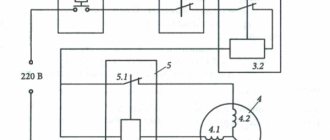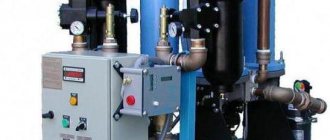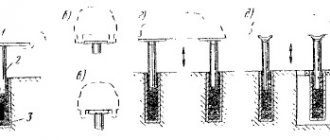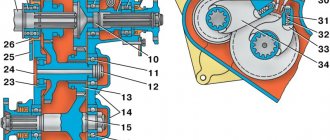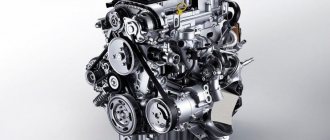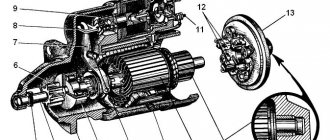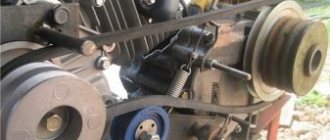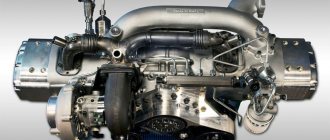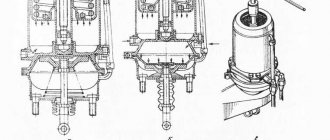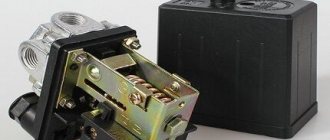- home
- News
- Screw compressor: device, principle of operation.
/
/
A screw compressor is a compressor in which pressure reduction is achieved by rotating two screws (rotors). By design, such devices belong to rotary compressor equipment. The screw model was first patented in 1934. Today, units of this type are the most common in their segment. This is facilitated by their relatively low weight and compact dimensions, reliability, ability to operate autonomously, and efficiency in terms of energy consumption and maintenance costs. The low level of vibration makes it possible to install such systems without installing a special foundation, as is the case with piston analogues. In a number of areas (ship refrigerators, mobile compressor stations, etc.), rotary models have almost completely replaced compressors of other types. Such devices can supply air compressed up to 15 atm and have a productivity of 1–100 m3/min.
Advantages of screw compressors
Compared to centrifugal and piston models, devices of the described type have the following basic advantages.
- Extremely low (about 2–3 mg/m3) oil consumption, which is several times less than that of large piston models with lubricant lubrication. Consequently, the air supplied through screw units will be much better and cleaner. It can be used to power the latest pneumatic equipment without installing additional filters.
- Reduced vibration and noise levels (for some models, comparable to the noise level of household appliances). Taking into account their low weight and dimensions, this makes it possible to install the described devices without a special foundation directly in industries where compressed air is consumed, as well as to equip them with various mobile complexes.
- Availability of air cooling. First, it eliminates the need to install water recycling systems. Secondly, it becomes possible to reuse the heat that is released as a result of the operation of the compressor, for example, for heating rooms.
- Reliable operation, safety and ease of operation, the ability to function for a long time without maintenance. This becomes possible thanks to the presence of automatic systems through which the operation of the unit is controlled and monitored.
What to look for when choosing a suction valve
For any valve, no matter what design it is, the throughput indicator is important, since it determines whether the compressor will have enough raw materials to produce compressed air in the amount declared by the manufacturer.
When selecting a suction valve to replace a worn-out unit, try to buy a device of a similar model and structure. Check the compressor data sheet, which indicates the model of each component used in assembling the air station.
If it is not possible to look at the technical passport, it is advisable to consult a competent specialist. For example, from the manager of our store, who can tell you which catalog item to order. Matching the purchased suction valve with the one being replaced will ensure that functionality is maintained during subsequent operation of the unit.
Screw compressor design
The standard model consists of the following elements.
- A filter necessary to purify the air entering the unit. Usually it consists of a primary filter, mounted directly on the housing at the point where air masses are taken from the atmosphere, and a secondary filter, which is installed in front of valve 2.
- Suction valve. Allows you to prevent the release of oil and compressed air from the compressor when it stops. Operates on pneumatic control. The design is a conventional spring-loaded valve. Some devices are equipped with proportional analogues.
- Screw block. It represents the main working part of the unit. Consists of two screws (rotors) manufactured through high-precision machining and placed in a housing. The most expensive element of the device. The rotor pair is equipped with a thermal protection sensor mounted near pipe 18. This controller turns off the motor if the temperature at the rotor outlet exceeds 105 °C.
- Belt drive (high-power models are equipped with direct clutch transmission or gearboxes). Sets the speed at which the propellers rotate. It consists of 2 pulleys, one of which is installed on the rotor pair, the other on the engine. The higher the speed, the higher the compressor performance, but the maximum pressure (working) decreases.
- Pulleys, the size of which determines the speed of rotation of the screw pair 4.
- Engine. Rotates the rotors 4 via a belt drive (in newer models - a clutch or gearbox). Equipped with a thermal protection sensor that disconnects the motor from the network when the maximum permissible values of consumed electric current are reached. Together with the sensor described in paragraph 3, it ensures the safe operation of the device and protects it from emergency situations.
- Oil filter. It cleans the oil before returning it to the rotors.
- Primary oil separator. Here the air is freed from oil under the influence of centrifugal force (the flow swirls, as a result of which the particles are separated).
- Oil separating filter. Provides a second stage of cleaning. This integrated approach makes it possible to minimize residual oil vapor at the outlet to 1.3 mg/m3, which is an unattainable value for piston units.
- Safety valve. Necessary for safety. The valve is activated if the pressure in the oil separator 8 exceeds the permissible limit.
- Thermostat providing the desired temperature. It passes the oil composition, not heated to 72 °C, past the cooling radiator 9. This allows you to speed up the achievement of the optimal temperature.
- Oil cooler. After being separated from the compressed air, the hot oil enters this tank, where it is cooled to the desired temperature.
- Air cooler. Before being supplied to the consumer, the compressed air is cooled here to a temperature that is 15–20 °C higher than the environment.
- Fan. Intakes air and cools working elements.
- Idle valve (electro-pneumatic). Controls the functioning of suction valve 2.
- Pressure switch. Ensures the unit operates in automatic mode. In new compressors, the relay is replaced by an electronic control system.
- Pressure gauge. Located on the front panel, it shows the pressure inside the compressor.
- Outlet pipe.
- A transparent cylindrical thickening on the tube, necessary for visual control of the oil return process.
- Minimum pressure valve. As long as the latter does not exceed 4 bar, it will always be closed. This element also functions as a check valve, since it separates the pneumatic line and the compressor when the latter stops or operates in idle mode.
The device is housed in a housing, which is usually made of steel. It is coated with a non-flammable sound-absorbing compound that is resistant to oil and other similar substances. This is the design of the most common modification. Depending on the model and manufacturer, the design and configuration of the rotary compressor may vary.
Compressor operating principle
Through valve 2, air from the atmosphere, purified by filters 1, enters the rotor pair 3. Here it is mixed with oil. The latter is fed into the compression tank to perform the following tasks.
- Seal the gaps between screws 3 and housing 16, as well as between the cavities of the rotors. This allows you to minimize overflows and leaks.
- Eliminate contact between the screws by ensuring an oil wedge between them.
- Dissipate heat that is induced during air compression.
The air-oil mixture compressed in block 3 is supplied to the oil separator 7, where it is divided into components. The separated oil is cleaned on filter 6 and returned to block 3. Depending on the temperature, it can be pre-cooled in radiator 9, which is regulated by thermostat 8. In any case, the oil will circulate in a closed circle. The air enters the cooling radiator 13. After reaching the desired temperature, it is supplied to the compressor outlet.
Operating modes
- Start _ _ This mode serves to optimize the load on the electrical network when the compressor starts. The engine is turned on according to the “star” circuit, and after 2 seconds (counted by a timer, which turns on when you press the Start button), it switches to the “triangle” circuit, which corresponds to the operating mode. Low-power screw models operate on direct start.
- Worker. The pressure in the system begins to increase. To control it there are 2 pressure gauges. The first one is on the front panel and shows the parameters inside the compressor. The second is on the receiver, it serves to control the line. After reaching the maximum permissible pressure, the corresponding relay is activated, as a result of which the unit switches to idling from the operating mode.
- Idling. The engine and rotors rotate, moving gas along an internal circuit. This is necessary to cool the air masses. This mode serves to put the compressor into a standby state or acts as a preparation before shutting down completely. There is no idle speed in piston models. A detailed description of the device’s operation in this mode is as follows. Relay 16 gives the command that activates the idle air valve and the timing relay. The latter's parameters can be configured. The pneumatic valve opens the channel between the oil separator filter 9 and the suction valve 2, as a result of which the pressure inside the compressor begins to decrease at such a rate as to reach the minimum mark (2.5 bar) within a set time. This allows you to stop the engine without releasing oil into filter area 1. After the specified period, the time relay gives the command to turn off the engine. The system enters the standby state. If the compression reaches a minimum value before the time relay is triggered, the operating rhythm starts again.
- Expectation. Continues until the operating pressure drops below the minimum mark, after which relay 16 starts the mechanism again. The duration of this mode depends on the rate of air consumption.
- Stop . _ Serves for normal shutdown of the unit. If the compressor was in operating rhythm, it will go to idle for a while and only then turn off.
- Alarm - stop - emergency shutdown. The corresponding button is located on the control panel. The mode is used in cases where it is necessary to urgently stop the engine. The unit turns off immediately, without an intermediate transition to idle speed.
Refrigerator compressor - what is it?
- 5.1. Piston compressor device
- 6.1. Crank compressor
- 14.1. Related articles:
A compressor is a device that compresses a substance (in our case, it is a refrigerant in the form of freon), as well as moving it through the cooling system.
It is thanks to this device that warm air is removed from refrigeration chambers, and the products in them are cooled to the required temperature or frozen.
There are only three main types of compressors installed on household refrigerators:
- classical;
- linear;
- inverter
An inverter compressor differs from the other two in that it operates continuously, maintaining the set temperature in the chambers. Devices of this type are installed on some modern models of refrigeration units, but the production of such equipment is much more expensive, which increases the final price tag for it.
Types of screw compressors
Oil filled. One rotor in them is the driving one, the second one is the driven one. Physical contact between these elements is prevented by injected oil (1 l/min is supplied per 1 kW of device power). The operating noise of such equipment is at the noise level from household appliances - 60–80 dB (subject to the use of sound-absorbing casings). Engine power can vary between 3–355 kW, and volumetric flow rates can range from 0.4–54 m3/min. Such equipment can be installed directly in workshops.
Oil-free . They are divided into two subspecies.
- Dry compression screw compressors Equipped with synchronous electric motors that drive both propellers, eliminating contact between them. They are less productive compared to oil-filled models. Due to the lack of oil, there is no heat dissipation. Therefore, the compression level reaches only 3.5 bar in one stage. This indicator can be raised to 10 bar if you use a second stage and an intermediate refrigerator. But this, like the use of two electric motors instead of one, increases the cost of the device.
- Water filled compressors. The most technologically advanced model, combining all the advantages of oil-free and oil-filled options. Water-filled units provide optimal performance and allow a compression of 13 bar in one stage. An important advantage of such models is their environmental friendliness, because traditional compressor oil is replaced with clean, natural and less expensive water. This ensures internal cooling. Water has high thermal conductivity and heat capacity. Regardless of the level of final compression, the temperature during this process increases by a maximum of 12 °C. This is facilitated, among other things, by the use of dosed injection. The thermal load on the device elements is minimal, therefore, the service life, reliability and safety of the unit as a whole increases. Compressed air does not require additional cooling. The water circulating in the system is cooled to ambient temperature. And the moisture present in the compressed air masses condenses and returns to the circuit. In oil-filled models, it was the condensate that was the pollutant. Here it is used in the circulation circuit within a few hours (under normal conditions and continuous operation of the device). Consequently, the accumulation of waste at the station is practically leveled out. Another significant advantage of water-filled compressors is the ability to reduce energy costs by 20%. The compression process in such devices approaches ideal isothermal. Manufacturing the device is cheaper due to the absence of oil filters and containers for waste oil fluid. There is no need to incur costs for condensate processing.
Oil-free models are used in a variety of areas, but the most popular applications are in the food, pharmaceutical and chemical industries.
Why is it profitable to switch to screw compressor equipment?
As noted above, rotary models are gradually replacing piston and centrifugal options. Many enterprises are switching to such units, considering them more reliable, advanced and economical. At the same time, the cost of rotary devices is higher than that of piston analogues. And to replace equipment (if we are talking specifically about upgrading the system, and not about assembling a new installation), you need to spend a certain amount. Let’s look in more detail at what exactly the benefits are for entrepreneurs by comparing screw and piston models. But first you need to understand what cost items make up the cost of any compressor. The final amount includes the following costs.
- Purchase of a unit.
- Payment for installation work.
- Purchase of consumables.
- Payment for electricity consumed by the device.
- Repair costs.
- Purchase of additional equipment. For example, this could be a purification complex for compressed air.
Costs for purchasing the unit
In this regard, piston models are more profitable, the price of which is 20–40% lower than the cost of screw analogues. At the same time, these are funds spent directly on the purchase of equipment. But it also needs to be installed. Piston models have larger dimensions and weight; during operation they vibrate noticeably, so they require a special foundation. This significantly increases installation costs. If we compare the total amount that needs to be spent on the purchase of equipment and its installation, then rotary options turn out to be more profitable.
Electricity costs
The efficiency of rotary compressors is significantly higher. And the higher the unit’s performance, the more noticeable this difference will be. The type of device also matters. For example, water-filled models provide higher energy savings. But even low-performance oil-filled options equipped with a traditional control circuit pay back their cost several times over the course of the operating period due to electricity savings alone. In terms of energy consumption to generate the same volume of compressed air, piston units are noticeably inferior.
Some screw models can further increase energy savings. We are talking about two-stage units and devices with variable engine speed. Such equipment provides additional savings of 30%. It is also important that it is possible to regulate the performance of the unit. In other words, the compressor will generate as much compressed air as the equipment consumes at any given moment. With this operating mode, there will be no excess or shortage. The equipment will function with the required performance, spending energy resources only on useful work.
Maintenance and repair costs
Piston compressors require regular replacement of piston rings, valves, liners and other mechanism elements. Rotary models completely relieve the user of such problems. There are no quickly wearing elements in their mechanism. The need for repairs occurs much less frequently, and routine maintenance is much cheaper. If you follow the operating instructions, such a unit can last about 20 years, operating without repairs in three shifts.
The cost of maintenance is also reduced because there is no need for the constant presence of maintenance personnel near the equipment. Rotary models are equipped with protection that prevents emergency situations. For example, equipment turns off when overheated or when electrical current peaks and is capable of operating in a completely autonomous mode.
Unlike piston models, rotary analogues support the possibility of being equipped with electronic control units, which allow you to set the operating parameters of the unit at the software level for several weeks in advance. Using an electronic unit, you can control a group of several mechanisms, stopping or starting some of them depending on the production needs for compressed air. Thus, the complex operates with maximum productivity and without wasting resources.
Purchasing consumables
Screw compressors have a more efficient oil separation system, which can significantly reduce the amount of oil fractions mixed with compressed air. If the cost of the main consumable decreases, then the cost of its acquisition also decreases. Such units have a more advanced design (when compared with piston analogues), which allows the installation of modern coolant. The latter can reduce the frequency of changing the oil composition several times.
Purchasing additional equipment
Since oil fractions are separated more efficiently in screw models, there is no need to purchase additional cleaning complexes. And if you choose a cheaper piston unit, you will also have to purchase a receiver that dampens pressure pulsations occurring in the pneumatic system. Rotary analogues do not generate such pulsations. In most cases, this avoids the purchase of additional receivers.
The operating noise of screw units is much lower than that of piston devices. By installing noise-absorbing enclosures, you can further reduce the sound level and vibration that occurs during the operation of compressor equipment. This allows it to be installed directly in workshops where compressed gas is supplied. The shorter the distance over which the air moves, the less condensed moisture and solid fractions appear in it, which can seriously damage production equipment.
Decentralization of this type of compressor equipment allows you to launch only those units that were needed at a particular point in time to ensure the production of compressed gas in the required volumes. An additional benefit that should be mentioned is the ability to use the heat generated by the compressor for the needs of the enterprise. It is often used for heating workshops.
Summary
Rotary models are inferior to piston analogues of equal performance only in terms of purchase price. For all other items (repair costs, purchase of additional equipment and consumables, payment for energy consumption and work of maintenance personnel), they are much more profitable and pay for themselves several times over the operating period. Thus, the purchase of screw compressor equipment is an economically justified and beneficial decision for the enterprise.
Variable drive models
In the mid-1990s rotary compressors equipped with a frequency drive were created. The appearance of such equipment was a big step towards the development and implementation of energy-saving technologies in production. The cost of energy resources is constantly increasing. It is natural that when modernizing their facilities, enterprises try to select the most cost-effective options for replacing outdated equipment. And their choice often stops at rotary units with frequency drives. In addition to reliable operation and the ability to function autonomously, such units can significantly optimize energy costs.
Features of the design and operation of frequency drives
This type of drive consists of a frequency converter and an asynchronous motor. The latter converts electricity into mechanical energy, driving a rotor pair. The frequency converter is used to control the motor. It modifies alternating current of one frequency into alternating current of another frequency.
In the technical literature, the term “variable frequency drive” is more common. This name is due to the fact that the motor speed is adjusted by varying the frequency of the supply voltage, which is supplied to the engine by a frequency converter. Today, such drives are widely used in various industries. For example, they are used in pumps that provide additional fluid pumping for heating and water supply networks.
Differences between inverter and linear refrigerator compressors
Speaking about the disadvantages of this type of compressor for refrigerators, it is worth saying that a linear unit is somewhat inferior to an inverter unit due to constant switching on and off. In this regard, the system suffers regular overvoltages, and this affects the electrical network and the load on it. In addition, when choosing, buyers pay great attention to electricity consumption - in the linear type it is higher.
But inverter units have several advantages:
Electricity consumption is reduced to a minimum, which cannot be said about the linear compressor; No extraneous intrusive noise - the unit operates without reaching maximum speed; Increased operating time of such equipment due to the absence of voltage surges and periodic shutdowns, which does not imply a high load on the system.
Having looked at the list of advantages of inverter refrigerators, it cannot be said that linear systems are definitely worse. No, they also have their advantages, thanks to which they are in demand:
They are environmentally friendly equipment - coolants are used for operation with absolute safety. The second name for such refrigerators is “green”. They began to be called that due to their environmental friendliness; The linear compressor is characterized by energy efficiency, its high efficiency deserves an A++ energy consumption class; Minimal vibration and absence of noise during operation of the unit, as well as when it is turned on and off. The device is equipped with silent start and stop options.
Inverter refrigerators with this type of compressor have very quickly become part of our lives. But not everyone is ready to give up a linear device, which is inferior in cost, to enjoy the silent operation of the unit, given that the freezing quality of both types is the same.
At the same time, linear models are no less durable, environmentally friendly and energy efficient than inverter models. And we have all long been accustomed to the fact that a refrigerator operating in the kitchen makes noise and vibration - we do not pay attention to it.
Working principle of a refrigerator compressor
To understand the purpose of this device, you should consider the operating diagram of the equipment.
A simplified version, where only the main structural elements are indicated, is given below.
Rice. 1. Operating principle of the refrigeration unit
Designations:
- A - The evaporative radiator is usually made of copper tubes and is located inside the chamber.
- B – Compressor apparatus.
- C – Condenser, is a radiator assembly located on the rear side of the installation.
- D – Capillary tube, used to equalize pressure.
Work algorithm:
- Using a compressor (B in Fig. 1), refrigerant vapor (usually freon) is pumped into the condenser radiator (C). Under pressure, they condense, that is, freon changes its state of aggregation, passing from vapor to liquid.
- The radiator grille dissipates the heat generated in this case into the surrounding air.
- After leaving the condenser, the liquid refrigerant enters the pressure equalizer (capillary tube D). As you move through this unit, the freon pressure decreases.
- Liquid refrigerant under low pressure enters the evaporative radiator (A), where under the influence of heat it again changes its state of aggregation. The evaporative radiator is cooled, which in turn leads to a decrease in the temperature in the chamber.
Next, the cycle is repeated until the required temperature is established in the chamber, after which the sensor sends a signal to the relay to turn off the electrical installation.
Crank compressor
A simplified diagram looks like a cylinder with a piston inside. The reciprocating movement of the piston is carried out using a crank mechanism, which is attached to the electric motor shaft. One rotation of the shaft completes a full working cycle. And the principle of operation of a refrigerator compressor can be illustrated as working in two phases:
- Movement "from the cylinder". A vacuum zone is created behind the piston; refrigerant vapors are sucked into the compressor from the evaporator through its open valve. The discharge valve to the condenser is closed.
- Movement "into the cylinder". The suction valve closes. Excessive pressure is created in the cylinder. The compressed refrigerant vapor is heated and pushed through the opening discharge valve into the condenser, where it cools and turns into a liquid state.
Important! In the low-power range (for household refrigerators), sealed units in a steel one-piece housing are almost universally used. The advantage of the design is that the compressor-motor is cooled directly by the refrigerant vapor. But such models cannot be repaired, and the refrigerator malfunction is eliminated by replacing the compressor.
Crank compressor
The fundamental difference between this type is the method of creating a reciprocating motion for the piston. The design does not use a crankshaft with two support points, but a console (stage) with one support point on the crank. That is, the rotational pair is replaced by a reciprocating element.
Such a device facilitates the assembly process for single-cylinder compressors, or rather, simplifies their adjustment by compensating for inaccuracies in actual production by means of small axial displacements of the stage. This type of low-power compressor is cheaper to manufacture and costs less.
Important! For a single-piston rocker compressor there is even the concept of “complete self-installation of parts.” This is possible due to the one-way orientation of each moving element - the shaft with the crank, the rocker and the piston.
Two-cylinder models do not have this advantage. Although in practice, an opposed compressor design is used, when the second rocker is welded to the crank on the other side, and the second piston is located on the same axis as the first, but on the other side of the engine shaft.
The disadvantage of the design is the power limitation. The cantilever shaft can withstand less load than the crankshaft.
This type is installed in small refrigerators, in two-chamber models with two compressors and small volumes of chambers (or one of them).
Linear compressor
This is a type of piston unit. In cross-section, the drive can be represented as a solenoid in which the piston rod moves in the electromagnetic field of a cylindrical coil. And DC solenoids create a significant force directed along the axis of the coil and are used as a power magnetic drive.
A linear compressor operates according to the following simplified scheme:
- A constant voltage is applied to the coil. The piston begins to move forward.
- Upon completion of the movement, the coil is turned off, and the piston returns to its original state using a spring.
The absence of an electric motor and crank transmission reduces the noise level and reduces power losses to overcome friction forces (higher energy consumption class). For these two characteristics, linear compressors are the best for home refrigerators.
Rotary compressor
This type does not have pistons, and operation is ensured by the movement of two screw-shaped rotors with mating planes in the stator. If we draw an analogy with piston models, then the role of the cylinder is played not by the stator, but by the enclosing rotor - as it moves towards the discharge side, the volume between the plates decreases.
The internal, male rotor performs the function of a piston - its plates provide compression of the flow in front and rarefaction of the gas environment at the rear.
This type is used in medium and high power refrigeration systems - with the same characteristics as piston analogues, the compressor dimensions are smaller. The cooling performance of small models is inferior to piston models with the same dimensions.
Another type of rotary type is the scroll compressor. It consists of two spirals “threaded” into one another. The upper spiral is motionless and has a discharge hole in the center of the base. Suction occurs when the internal spiral moves at the periphery of the system.
Just like screw models, maximum efficiency is possible only for medium and high power refrigeration units. Therefore, the main “household” application is air conditioning systems.
Which refrigerator compressors are best?
There are no ratings of the best refrigerator compressors. Most modern manufacturers produce only refrigerator models with a certain type of compress. In this case, you need to decide for yourself what is more important - choose a refrigerator based on the manufacturer or type of compressor. Some manufacturers are developing their own models. Samsung is one of these companies.
The choice of compress type will determine how long the refrigerator will operate without replacement or repair. Therefore, it is best to buy a model with an inverter device. They are characterized by a long service life and minimal energy consumption.
Linear devices are the optimal solution for those who value long-term freshness of products. Collector models, although they are among the simplest and oldest. But at the same time, due to their affordable price, they are still popular.
Video: which refrigerator compressor is better
Which refrigerator compressor is best?
Watch this video on YouTube
Do you want to understand better than others?
- Operating principle of a starting protection relay for a domestic refrigerator - The compressor drive of a domestic refrigerator is usually an asynchronous electric motor powered by a single-phase 220 V network. Its peculiarity is that when starting...
- Structure, principles of operation and design of household refrigerators - When the owner clearly understands the operating principle of the refrigeration unit, he has the opportunity to extend the service life of the household appliance. Understand how it works...
- The principle of operation of compressor, absorption and thermoelectric refrigerators - Fundamentally, the refrigerator is a closed thermally insulated chamber in which a constant low temperature is maintained. If it were perfect...
- How does an absorption refrigerator work - A household absorption refrigerator helps keep food fresh for a long time. This article will tell you about the possible types of refrigerators and their operating principles. Absorption…
- Electrical diagram of a refrigerator - The article will talk about electrical connection diagrams for refrigerators from different manufacturers, answers to your questions: what does the connection diagram look like, what is it,...
Repair kits for intake valves
We can supply you with the following repair kits:
- intake valve repair kits;
- control units for intake valves;
- pneumatic cylinders for intake valves;
- solenoid valves.
| Product name | Installation location |
| 510.0163 | intake valve R20E |
| 510.0363 | intake valve R40E |
| 510.0564 | intake valve R90E |
| 510.0360 | intake valve RH100E |
| 510.5760 | intake valve RH250E |
| 510.0160 | intake valve RB60E |
| 510.0360 | intake valve RB80E |
| 510.5160 | intake valve RB115E |
| 510.7160 | intake valve RB115P |
Any screw compressor includes a loading system for pumping atmospheric air into the operating unit. Controlling the operating modes of the compressor unit, monitoring the output of the unit, and regulating the injection of air into the screw assembly is provided by an important part called the inlet valve. It keeps the compressed air from reversing, ensures consistent pressure reduction during breaks in machine operation and ensures normal functioning of the compressor module.
Refrigerator compressor class
Energy consumption classes are designated by letters from A to G. The most profitable in this sense are class A and its even more economical varieties A+, A++, A+++. You can also see the climate zone in the passport - N, SN, ST, T. According to the consultant, the first two (with which almost all refrigerators sold are labeled) are optimally suited for our climate, the rest are for hotter ones. Theoretically, this could affect the conditions of warranty repair if the temperature conditions during operation were not observed.
VMC intake valves
Trading House AERO offers inlet valves for screw compressors manufactured by the Italian company VMC from a warehouse in Mytishchi. Correspondence table between old and new intake valve models
| power, kWt | New model | Old model |
| 4/5,5 | RH30 3/4″ | RH5 |
| 11 | RH30 1″ | RH10 |
| 18,5 | RH38 | RH25 |
| 22 | RH38 | RH25 RH40 |
| 22 | RH60 | RH25 RH40 |
| 30 | RH60 | R40 |
| 18,5/22/30/37 | RB60 | R40 |
| 37 | RB60 | R90 |
| 45/55 | RB80 | R90 |
| 75 | RB80 | RH100 |
| 90 | RB90 | RH180 |
| RH250 | ||
| 100/132/160 | RB115 | RH350 |
| 250/215/350 | RB200 | RH600 |
Specifications
| Model | Nominal diameter, mm | Compressor power, kW | Productivity, m3/min | Execution | Weight, kg |
| RH30 | 20 or 30 | 4-11 | 0,2-1,8 | E, NR | 0,3 |
| RH38 | 38 | 7,5-22 | 1,2-3,5 | E, NR | 0,8 |
| RH60 | 62 | 22-37 | 3-7 | E, NR, P, PM | 1,5 |
| RB60 | 6 (60) | 22-37 | 3,5-7 | PM, E, NR | 2,2 |
| RB80 | 8 (80) | 45-75 | 6-12,2 | 3,0 | |
| RB90 | 9 (90) | 90 | 7-15 | 6,5 | |
| RB115 | 11,5 (115) | 110-160 | 15-27 | 10,0 | |
| RB125 | 12,5 (125) | 132-200 | 17-32 | 11,0 | |
| RB140 | 14,0 (140) | 180-250 | 20-40 | 12,3 | |
| RB200 | 2*14,0 (140) | 250-350 |
